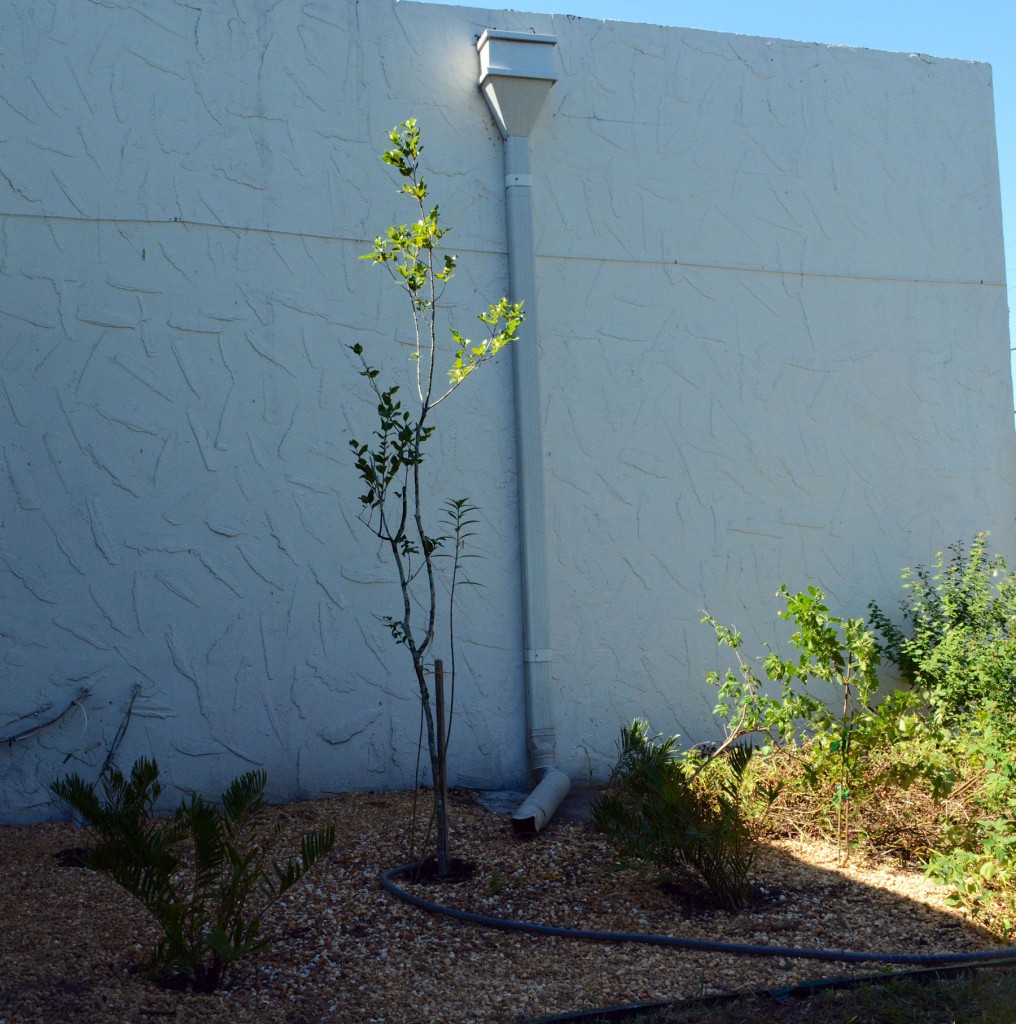It was my dad’s 70th birthday last week, and to celebrate the occasion I sent him a pair of the most comfortable work gloves I’ve ever owned. Turns out my timing was good: the next day he planned to start a major lawn-reduction project involving the removal of hundreds of square feet of sod, the installation of dozens of railroad ties, etc. Serendipity!
Not to be outdone, I had to put my own pair to good use, which I did over the weekend with an overhaul of a neglected corner of our yard, right outside one of the kids’ bedroom windows. There had been a very large gumbo limbo tree there, but it died nearly a year ago. That corner is also where our electrical and phone service comes into the house, and it’s right next to the downstairs A/C air handler. All told, pretty busy and, because fairly workmanlike, I’d neglected it to the extent that it was overgrown with grass runners, balsam apple vines, and whatever wildflowers happened to spring up from the bird poop of the birds who’d graced the tree earlier. (And in fact, we got some lovely plants there: a large bed of dune sunflower, some scorpion’s tail, and a few Cordia globosa shrubs.)
Nevertheless, something needed to be done to clean up that area, and when we had our native plant landscaper down to do her semiannual trim over at Mom’s place, I decided to profit from the occasion to have her over to our place to offer some suggestions.
One thing she strongly recommended was that we remove that gumbo limbo. I had wanted to leave it up as a snag for wildlife, but it turns out that is not such a good idea (even though as we were talking about it, looking right at it, a downy woodpecker was methodically searching the upper branches for food!). Gumbo limbo wood is very light, not well suited for a snag tree, and all it might do is attract pests and/or pose a slight hazard for falling limbs. Furthermore, even when the tree was alive, it was not really helping our home. It was so large that several large limbs overhung the flat roof and were constantly raining down twigs, leaves, and berries that clogged the downspouts and actually caused pretty serious water damage. (This mainly because the previous owners never bothered to fix a thing. They had bought high during the real estate bubble, and when they realized that they were destined to sell low, they made the strategic decision not to keep the property maintained. At all.)
Anyway, the tree needed to come out. But all I have are hand tools: a hatchet, a pole trimmer with a limb saw, and a large bow saw for evening up Christmas tree bottoms. I really thought that I would need a chainsaw, but before I ran out to the home center to pick up that dangerous power tool I decided to see if I “really needed it.” So I attacked the dead tree with my hand tools and a lot of good old-fashioned sweat. And, lo and behold, out came the tree! (As you might expect, the stump was the hardest part, but a shovel, the hatchet, and a lot of elbow grease got it out in much less time than I’d feared.)
So I knew I wanted a tidier tree, one that, if it did ever grow to the height of the roof, would be easy to prune back the crown without damaging the tree. I had solicited ideas for replacements from our landscape consultant, looking for two things: increased species diversity and a more manageable tree. The suggestion of hers that I liked the best was black ironwood (Krugiodendron ferreum). As I knew from my experience with it at the old place, it doesn’t grow fast, and the crown tends to stay pretty manageable. As far as I know, black ironwood isn’t the larval host plant for any butterflies, but apparently its small flowers attract lots of nectaring insects, and its fruits are prized by many species of bird.
It’s a very slow-growing tree, with wood so dense that dry logs of it sink in salt water, this tree is tough (good for a yard that sees lots of rampaging little boys) and drought-resistant. It doesn’t look like very much right now:

But with the coonties (Zamia pumila) around the base and the pea gravel throughout (those 21 bags of gravel are why I needed those work gloves!), the overall effect is much nicer, and once the plantings are established, I suspect this will become one of my favorite places in the yard. I’ve already dragged a chair from the deck over onto the lawn so I can just sit and look at it; I haven’t done that for any of the other plantings I’ve put in.
Taxonomy
In case you’re wondering, Krugiodendron ferreum is in the buckthorn family (Rhamnaceae). If that tells you anything, it tells you more than me. The name of the genus honors Leopold Krug; the specific epithet comes from Latin ferrum, iron. A nursery down in Miami-Dade has a nice informative page about the tree.
I’ll write more about the coonties in a later post.
Cheers!

1 thought on “New backyard planting: Black Ironwood, Krugiodendron ferreum”